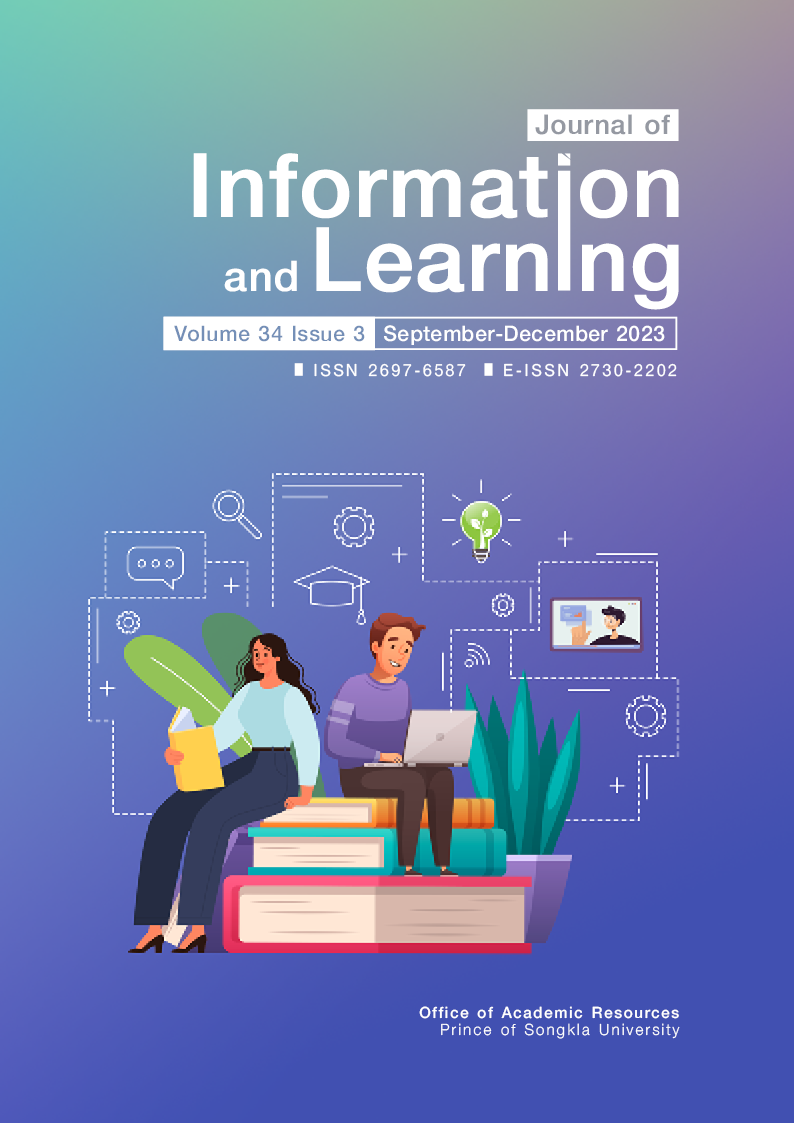การวิเคราะห์การมีส่วนร่วมของผู้ใช้สื่อสังคมต่อประสิทธิภาพในการจัดการของรัฐบาล คุณลักษณะความเสี่ยงและการตอบสนองเชิงอารมณ์ต่อปัญหาฝุ่นละอองขนาดไม่เกิน 2.5 ไมครอน (PM2.5) ด้วยข้อมูลเชิงลึกจากเครื่องมือรับฟังเสียงสังคม
Main Article Content
บทคัดย่อ
งานวิจัยเรื่อง การวิเคราะห์การมีส่วนร่วมของผู้ใช้สื่อสังคมต่อประสิทธิภาพในการจัดการของรัฐบาล คุณลักษณะความเสี่ยง และการตอบสนองเชิงอารมณ์ต่อปัญหาฝุ่นละอองขนาดไม่เกิน 2.5 ไมครอน (PM2.5) ด้วยข้อมูลเชิงลึกจากเครื่องมือรับฟังเสียงสังคมประยุกต์ใช้โมเดลการค้นหาข้อมูลความเสี่ยงและการประมวลผลในการออกแบบกรอบแนวคิดเชิงทฤษฎี โดยมีวัตถุประสงค์เพื่อศึกษาจำนวนการกล่าวถึงและการมีส่วนร่วมของผู้ใช้สื่อสังคมต่อการประสิทธิภาพในการจัดการของภาครัฐ คุณลักษณะความเสี่ยง และการตอบสนองเชิงอารมณ์ต่อปัญหาฝุ่นละอองขนาดไม่เกิน 2.5 ไมครอน (PM2.5)
โดยใช้เครื่องมือรับฟังเสียงสังคม Mandala.AI Cosmos เพื่อศึกษาจากช่องทางเฟซบุ๊ก ทวิตเตอร์ อินสตาแกรม และติ๊กต็อก ในช่วงระหว่างวันที่ 1 พฤศจิกายน พ.ศ. 2565 ถึง 30 เมษายน พ.ศ. 2566 โดยงานวิจัยนี้ประยุกต์ใช้โมเดลการค้นหาข้อมูลความเสี่ยงและการประมวลผลในการออกแบบตารางบันทึกการเก็บข้อมูลเพื่อค้นหาการมีส่วนร่วมของผู้ใช้สื่อสังคมต่อการแสดงความคิดเห็นเกี่ยวกับประสิทธิภาพการจัดการของภาครัฐ คุณลักษณะความเสี่ยง และการตอบสนองเชิงอารมณ์ต่อปัญหาฝุ่นละอองขนาดไม่เกิน 2.5 ไมครอน (PM2.5) สำหรับสถิติที่ใช้สำหรับการวิเคราะห์ข้อมูล คือ สถิติเชิงพรรณนา ได้แก่ ความถี่และร้อยละ
ผลการวิจัยพบว่า ผู้ใช้สื่อสังคมในประเทศไทยกล่าวถึง ฝุ่นละอองขนาดไม่เกิน 2.5 ไมครอน (PM2.5) จำนวน 5,037 ครั้ง และมีส่วนร่วม 1,404,408 ครั้ง จาก 2,410 บัญชี ทั้งนี้มีการกล่าวถึงฝุ่นละอองขนาดไม่เกิน 2.5 ไมครอน (PM2.5) ในช่องทางเฟซบุ๊ก มากที่สุด (3,631 ครั้ง) รองลงมา ได้แก่ ทวิตเตอร์ (1,058 ครั้ง) อินสตาแกรม (301 ครั้ง) และ ติ๊กต็อก (47 ครั้ง) ตามลำดับ เมื่อพิจารณาถึงการสนทนาเกี่ยวกับประสิทธิภาพในการจัดการของภาครัฐ พบว่า มีผู้ใช้สื่อสังคมกล่าวถึงประเด็นที่ภาครัฐไม่แก้ไขปัญหาฝุ่นละอองขนาดไม่เกิน 2.5 ไมครอน (PM2.5) จำนวนน้อย (กล่าวถึง 31 ครั้ง การมีส่วนร่วม 3,224 ครั้ง) อย่างไรก็ตามมีผู้ใช้สื่อสังคมออนไลน์จำนวนมากในทุกช่องทางมีความคิดเห็นต่อคุณลักษณะความเสี่ยงด้านความเจ็บป่วย มะเร็ง และโรคปอด (กล่าวถึง 3,823 ครั้ง การมีส่วนร่วม 1,277,480 ครั้ง) และมีผู้ใช้สื่อสังคมประมาณครึ่งหนึ่งมีการตอบสนองเชิงอารมณ์เชิงลบต่อฝุ่นละอองขนาดไม่เกิน 2.5 ไมครอน (PM2.5) (ร้อยละ 54.7)
Article Details

This work is licensed under a Creative Commons Attribution-NonCommercial-NoDerivatives 4.0 International License.
Journal of Information and Learning ดำเนินการโดยสำนักวิทยบริการ มหาวิทยาลัยสงขลานครินทร์ วิทยาเขตปัตตานี บทความที่ได้รับการตีพิมพ์ในวารสารได้รับความคุ้มครองตามกฎหมายลิขสิทธิ์ โดยเจ้าของลิขสิทธิ์จะมีสิทธิในการทำซ้ำ ดัดแปลง และเผยแพร่งานบทความ ทั้งรูปแบบอิเล็กทรอนิกส์ การทำฉบับสำเนา การแปล และการผลิตซ้ำในรูปแบบต่างๆ ลิขสิทธิ์บทความเป็นของผู้เขียนและสำนักวิทยบริการ มหาวิทยาลัยสงขลานครินทร์ วิทยาเขตปัตตานี วารสารฯ ขอสงวนสิทธิ์ในการพิจารณาตีพิมพ์ตามความเหมาะสม รวมทั้งการตรวจทานแก้ไข การปรับข้อความ หรือขัดเกลาภาษาให้ถูกต้องตามเกณฑ์ที่กำหนด สำหรับผลการวิจัยและความคิดเห็นที่ปรากฏในบทความถือเป็นความคิดเห็นและอยู่ในความรับผิดชอบของผู้เขียน
References
Department of Health. (2020). A study of risk perception and health behavior related to prevention of PM2.5 exposure among population in Bangkok metropolitan area. Ministry of Public Health. https://hia.anamai.moph.go.th/th/news-anamai/download/?did=205839&id=100490&reload=
Electronic Transaction Development Agency. (2022). Thailand internet user behavior 2022. Electronic Transaction Development Agency. https://www.etda.or.th/getattachment/78750426-4a58-4c36-85d3-d1c11c3db1f3/IUB-65-Final.pdf.aspx
Griffin, R. J., Dunwoody, S., & Neuwirth, K. (1999). Proposed model of the relationship of risk information seeking and processing to the development of preventive behaviors. Environmental Research, 80(2), 230-245. https://doi.org/10.1006/enrs.1998.3940
Griffin, R. J., Neuwirth, K., Giese, J., & Dunwoody, S. (2002). Linking the heuristic-systematic model and depth of processing. Communication Research, 29(6), 705-732. https://doi.org/10.1177/009365002237833
Griffin, R. J., Yang, Z., ter Huurne, E., Boerner, F., Ortiz, S., & Dunwoody, S. (2008). After the flood: Anger, attribution, and the seeking of information. Science Communication, 29(3), 285-315. https://doi.org/10.1177/1075547007312309
Guo, H., Chang, Z., Wu, J., & Li, W. (2019). Air pollution and lung cancer incidence in China: Who are faced with a greater effect? Environment International, 132, 105077. https://doi.org/10.1016/j.envint.2019.105077
Hovick, S. R., Bigsby, E., Wilson, S. R., & Thomas, S. (2021). Information seeking behaviors and intentions in response to environmental health risk messages: A test of a reduced risk information seeking model. Health communication, 36(14), 1889-1897. https://doi.org/10.1080/10410236.2020.1804139
Jeong, J. S., & Kim, S. Y. (2023). Risk perception and preventive behavior during the COVID-19 pandemic: Testing the effects of government trust and information behaviors. Health Communication, 1-12, https://doi.org/10.1080/10410236.2023.2166698
Jiang, X., Eum, Y., & Yoo, E. H. (2023). The impact of fire-specific PM2.5 calibration on health effect analyses. Science of The Total Environment, 857, 159548. https://doi.org/https://doi.org/10.1016/j.scitotenv.2022.159548
Kaeophet, S., Leknoi, U., & Jarusombuti, P., (2022). Responses to PM2.5 and socioeconomic conditions: A case study of motorcycle taxi drivers in Din Daeng District, Bangkok. Journal of Administration and Social Science. 5(2), 89-102. https://so03.tci-thaijo.org/index.php/assr/article/view/259702
Kim, H. K., & Kim, Y. (2019). Risk information seeking and processing about particulate air pollution in South Korea: The roles of cultural worldview. Risk Analysis, 39(5), 1071-1087. https://doi.org/10.1111/risa.13231
Li, Z., Tang, Y., Song, X., Lazar, L., Li, Z., & Zhao, J. (2019). Impact of ambient PM2.5 on adverse birth outcome and potential molecular mechanism. Ecotoxicology and Environmental Safety, 169, 248-254. https://doi.org/https://doi.org/10.1016/j.ecoenv.2018.10.109
Liu, C., Cao, G., Li, J., Lian, S., Zhao, K., Zhong, Y., Xu, J., Chen, Y., Bai, J., Feng, H., He, G., Dong, X., Yang, P., Zeng, F., Lin, Z., Zhu, S., Zhong, X., Ma, W., & Liu, T., (2023). Effect of long-term exposure to PM2.5 on the risk of type 2 diabetes and arthritis in type 2 diabetes patients: evidence from a national cohort in China. Environment International, 171, 107741. https://doi.org/10.1016/j.envint.2023.107741
Lohiniva, A. L., Sibenberg, K., Austero, S., & Skogberg, N. (2022). Social listening to enhance access to appropriate pandemic information among culturally diverse populations: Case study from Finland. JMIR infodemiology, 2(2), e38343. https://doi.org/10.2196/38343
Lv, S., Li, Z., Li, H., Liu, M., Wu, Z., Yu, S., Wu, B., Gao, B., Tao, L., Luo, Y., Guo, X. & Liu, X. (2023). Long-term effects of PM2.5 components on hypertension: A national analysis in China. Environmental Research, 222, 115323. https://doi.org/10.1016/j.envres.2023.115323
O'Hair, H. D., & O'Hair, M. J. (2020). The handbook of applied communication research. Wiley. https://www.wiley.com/enus/The+Handbook+of+Applied+Communication+Research%2C+2+Volume+Set-p-9781119399865
Oh, J., Choi, S., Han, C., Lee, D. W., Ha, E., Kim, S., Bae, H. J., Pyun, W. B., Hong, Y. C., & Lim, Y. H. (2023). Association of long-term exposure to PM2.5 and survival following ischemic heart disease. Environmental Research, 216, 114440. https://doi.org/https://doi.org/10.1016/j.envres.2022.114440
Pollution Control Department. (2020). Sathānakān læ kānčhatkān panhā monlaphit thāng ʻākāt læ sīang khō̜ng prathēt Thai [The state of air and noise pollution in Thailand]. Ministry of Natural Resources and Environment. https://www.pcd.go.th/publication/25841
Pollution Control Department. (2021). The state of air and noise pollution in Thailand. Ministry of Natural Resources and Environment. https://www.pcd.go.th/wp-content/uploads/2021/03/pcdnew-2021-04-07_06-54-58_342183.pdf
Pomputius, A. (2019). Can you hear me now? Social listening as a strategy for understanding user needs. Medical Reference Services Quarterly, 38(2), 181-186. https://doi.org/10.1080/02763869.2019.1588042
Shi, L., Wu, X., Yazdi, D. M., Braun, D., Awad, Y. A., Wei, Y., Liu, P., Di, Q., Wang, Y., Schwartz, J., Dominici, F., Kioumourtzoglou, M. A., & Zanobetti, A. (2020). Long-term effects of PM2.5 on neurological disorders in the American Medicare population: a longitudinal cohort study. The Lancet Planetary Health, 4(12), e557-e565. https://doi.org/10.1016/S2542-5196(20)30227-8
Shi, W., Liu, C., Annesi-Maesano, I., Norback, D., Deng, Q., Huang, C., Qian, H., Zhang, X., Sun, Y., Wang, T., van Donkelaar, A., Martin, R. V., Zhang, Y., Li, B., Kan, H.,& Zhao, Z. (2021). Ambient PM2.5 and its chemical constituents on lifetime-ever pneumonia in Chinese children: A multi-center study. Environment International, 146, 106176. https://doi.org/https://doi.org/10.1016/j.envint.2020.106176
Sirijaroonwong, U., Phungkat, Y., Bunprom, P., Thonhkhaimook, B., & Sangsiriwut, N., (2022). Perception and preventive behavior towards particulate matter among personnel: A case study of an organization in Bangkok. HCU Journal of Health Science, 26(1), 98-107. https://he01.tci-thaijo.org/index.php/HCUJOURNAL/article/view/255115
Stewart, M. C., Atilano, M., & Arnold, C., (2021). Improving customer relationship management through social listening: A case study of an American Academic Library. In I. Lee (Ed.), Diverse methods in customer relationship marketing and management (pp. 202-222). IGI Global. https://doi.org/10.4018/978-1-5225-5619-0.ch011
Stewart, M. C., Arnold, C. L., & Wisehart, D. (2023). Consequences of social listening via mediated communication technologies (MCTs): Application across levels of the communication hierarchy. International Journal of Social Media and Online Communities (IJSMOC), 15(1), 1-20. https://doi.org/10.4018/IJSMOC.324104
Wang, M., Han, Y., Wang, C. J., Xue, T., Gu, H. Q., Yang, K. X., Liu, H. Y., Cao, M., Meng, X., Jiang, Y., Yang, X., Zhang, J., Xiong, Y. Y., Zhao, X. Q., Liu, L. P., Wang, Y. L., Guan, T. J., Li, Z. X., & Wang, Y. J. (2023). Short-term effect of PM2.5 on stroke in susceptible populations: A case-crossover study. International Journal of Stroke, 18(3), 312-321. https://doi.org/10.1177/17474930221110024
World Bank. (2022). The global health cost of PM2.5 air pollution: A case for action beyond 2021. World Bank Publications. https://doi.org/10.1596/978-1-4648-1816-5
Yang, Z. J., Kahlor, L., & Li, H. (2014). A United States-China comparison of risk information–seeking intentions. Communication Research, 41(7), 935-960. https://doi.org/10.1177/0093650213479795
Yang, Z. J., Rickard, L. N., Harrison, T. M., & Seo, M. (2014). Applying the risk information seeking and processing model to examine support for climate change mitigation policy. Science Communication, 36(3), 296-324. https://doi.org/10.1177/1075547014525350
Yavuz, Ş., & Tire, E. (2023). A survey of corporate communication professionals' perspective on social listening and analytics. Corporate Communications: An International Journal, 28(4), 564-581. https://doi.org/10.1108/CCIJ-03-2022-0036
Zhang, W., Li, H., Pan, L., Xu, J., Yang, X., Dong, W., Shan, J., Wu, S., Deng, F., Chen, Y., & Guo, X. (2021). Chemical constituents and sources of indoor PM2.5 and cardiopulmonary function in patients with chronic obstructive pulmonary disease: Estimation of individual and joint effects. Environmental Research, 197, 111191. https://doi.org/10.1016/j.envres.2021.111191
Zhang, Y., Guo, Z., Zhang, W., Li, Q., Zhao, Y., Wang, Z., & Luo, Z. (2023). Effect of acute PM2.5 exposure on Lung function in children: A systematic review and meta-analysis. Journal of Asthma and Allergy, 16, 529-540. https://doi.org/10.2147/JAA.S405929
Zhao, H., Zhang, X., Wang, W., Shi, J., Lai, W., Li, Y., Zhang, C., Guo, L., Gong, J., Li, L., & Lu, C. (2023). Global, regional, and national burden of ambient and household PM2.5-related neonatal disorders, 1990-2019. Ecotoxicology and Environmental Safety, 252, 114560. https://doi.org/10.1016/j.ecoenv.2023.114560

